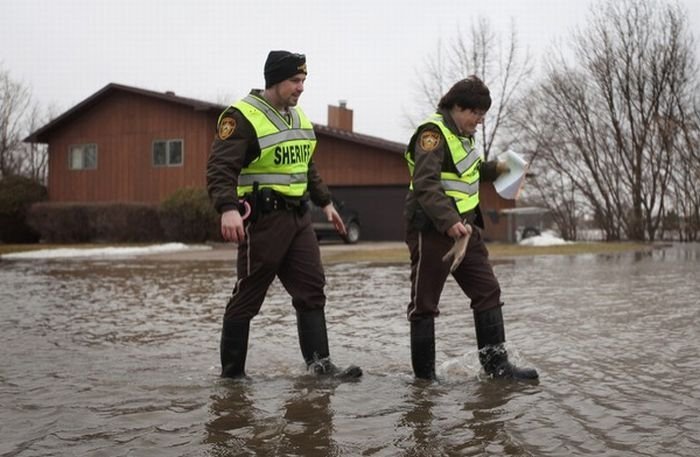|
|
2011 Red River Flood, North Dakota, Minnesota, United States
|
• Ice jams
On March 25, an ice jam formed north of Winnipeg, causing the municipalities of St. Andrews, St. Clements, East St. Paul and West St. Paul to declare a state of emergency. Flooding from the ice jam necessitated the evacuation of about thirty homes. While the jam was broken, it reformed near Lower Fort Garry, causing the water to rise 4.5 meters (14.7 feet) in 2 hours. On March 31, a state of emergency was declared for the city of Selkirk due to concerns over ice jams.
Dominion City was the first town in Manitoba to declare a state of emergency on Monday, March 23. Government officials handed out evacuation alerts to 850 residents. Forty homes north of Winnipeg were evacuated, while dozens of homes were flooded due to ice jams. On Thursday, March 26, some 95 elderly and special needs people were evacuated from the Roseau River Anishinabe First Nation. An engineering firm detonated charges downstream of Bismarck, North Dakota to clear an ice jam which was causing flooding in the city causing an evacuation of 1,700 persons. There were three million sandbags, rolls of poly film Hesco bastion flood walls, and water pumps sent out by the U.S. Army Corps of Engineers to North Dakota. Both North Dakota and Manitoba used backhoes from the river bank and from bridges, but these machines had a 20-foot (6.1 m) reach for a .25-mile-wide (0.40 km) river. A Chinook helicopter was deployed with a 1,400-kilogram (3,100 lb) concrete weight to try to break up an ice jam, but only small pieces of ice broke away. The North Dakota National Guard used 160 pounds (73 kg) of C-4 plastic explosives on the 3-foot-thick (0.91 m) ice placed into 80 holes. The ice was then coated with road salt to hasten melting. The Army Corps of Engineers also resorted to using sand, salt, chemicals and drilling to alleviate the ice jams. The Manitoba government chose not to use dynamite, as explosives work well on large ice sheets but not as well on broken and fused ice. To set the dynamite, holes need to be drilled in the ice, which would require someone to hang suspended from a helicopter. The end result of dynamite forms a hole centrally in the ice without loosening up the ice jam blockage to allow water to flow past. Manitoba purchased five new certified emergency response trailers (CERTs), which are 15-meter-long (49 ft) tubes with 60 compartments which can be filled with water and used to build dikes. These tubes take 10 minutes to fill up and provide the same protection as 500 sandbags. Volunteers created over 600,000 sandbags to shore up defences against the Red River and unpredictable flows caused by ice jams.
Amphibex excavator icebreakers were at work breaking up ice flows on the Red River. Ice breakers and backhoes were to be strategically placed along the Red River Floodway, which might have needed to be opened before the ice was fully melted. Officials examined past ice jams and provided contingency plans if the Floodway jammed upstream of bridges or on tight corners.
|
|









